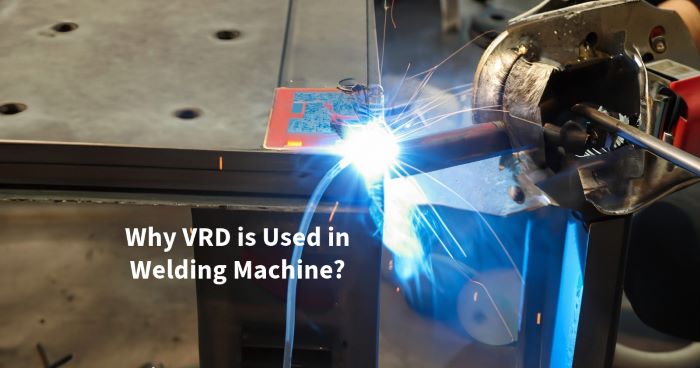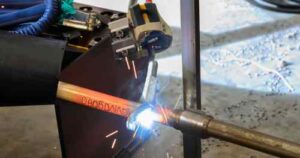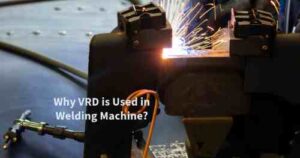Table of Contents
- 1. Why VRD is Used in Welding Machine
- 2. Importance of VRD in Welding Machines
- 3. How VRD Enhances Welder Safety
- 4. Different Types of VRD
- 5. Benefits of Incorporating VRD in Welding Machines
- 6. VRD’s Role in Compliance with Welding Standards
- 7. Factors to Consider When Choosing a VRD
- 8. Installation and Maintenance of VRD
- 9. Common Myths and Misconceptions about VRD
- 10. Future Trends in Welding Machine Technology
- 11. Comparing VRD with Other Welding Safety Mechanisms
- 12. Applications of VRD Beyond Welding
- 13. Case Studies: Successful Implementation of VRD
- 14. Addressing Concerns and Criticisms of VRD
- Pros of Voltage Reduction Device (VRD):
- Cons of Voltage Reduction Device (VRD):
- What is VRD in Stick Welding?
- How do you test a welder’s VRD?
- What is the purpose of the inverter welding machine?
- Why do we use low voltage in welding?
- Conclusion
- FAQs about VRD Welding Machine
In the realm of welding technology, safety and efficiency are paramount. One of the crucial components that ensure both these aspects is the Voltage Reduction Device (VRD). In this article, we delve into the reasons why VRD is used in welding machines, its significance, benefits, and how it functions to ensure welder safety.
1. Why VRD is Used in Welding Machine
Voltage Reduction Device (VRD) plays a vital role in welding machines, primarily to enhance safety during welding operations. It works by reducing the open-circuit voltage of the welding machine when it’s not in use for welding. This feature is particularly important because high open-circuit voltage can pose risks to welders, leading to electric shocks and other hazards.
2. Importance of VRD in Welding Machines
The key purpose of VRD is to reduce the risk of electric shock to welders. It prevents the welding machine’s electrode from reaching high voltages during non-welding periods, ensuring that the voltage remains at a safe level.
3. How VRD Enhances Welder Safety
VRD significantly enhances welder safety by limiting the no-load voltage to a safe range. This safety feature reduces the potential for electric shock, making welding operations much safer for operators.
4. Different Types of VRD
There are various types of VRD, including resistive, inductive, and capacitive VRD. Each type offers unique advantages and is suited for different welding applications.
5. Benefits of Incorporating VRD in Welding Machines
Incorporating VRD technology into welding machines brings multiple benefits. These include improved welder safety, compliance with safety regulations, reduced risk of electrical accidents, and enhanced welding efficiency.
6. VRD’s Role in Compliance with Welding Standards
Many welding safety standards and regulations mandate the use of VRD in welding machines, emphasizing the importance of this technology in ensuring a safe working environment.
7. Factors to Consider When Choosing a VRD
When selecting a welding machine with VRD, factors such as welding application, type of VRD, and the specific safety requirements of the work environment should be carefully considered.
8. Installation and Maintenance of VRD
Proper installation and regular maintenance of VRD are essential to ensure its optimal functioning. Welders and maintenance personnel should be trained to handle VRD-equipped machines.
9. Common Myths and Misconceptions about VRD
There are misconceptions surrounding VRD technology, including its impact on welding performance. Addressing these myths is crucial to fully appreciate the value of VRD.
10. Future Trends in Welding Machine Technology
As technology advances, VRD is likely to become even more sophisticated, offering higher levels of safety and integration with other welding technologies.
11. Comparing VRD with Other Welding Safety Mechanisms
While VRD plays a pivotal role in welder safety, it’s essential to compare it with other safety mechanisms to create a comprehensive safety strategy.
12. Applications of VRD Beyond Welding
The benefits of VRD technology extend beyond welding. It has potential applications in other industries where electrical safety is a concern.
13. Case Studies: Successful Implementation of VRD
Examining real-world cases where VRD has been successfully implemented can provide insights into its effectiveness and impact on welding safety.
14. Addressing Concerns and Criticisms of VRD
Some concerns about VRD technology include its cost and potential impact on welding performance. Addressing these concerns can help create a balanced view of VRD’s pros and cons.
Pros of Voltage Reduction Device (VRD):
- Enhanced Welder Safety: The primary benefit of VRD is improved welder safety. By reducing the open-circuit voltage to safe levels, VRD minimizes the risk of electric shock for welders and those in the welding environment.
- Compliance with Safety Standards: Many welding safety standards and regulations mandate the use of VRD in welding machines. Incorporating VRD ensures compliance with these safety guidelines, avoiding legal and regulatory issues.
- Prevention of Electric Shock: VRD prevents the buildup of high open-circuit voltage when the welding machine is not actively in use. This reduction in voltage significantly lowers the chance of electric shock, creating a safer working environment.
- Minimized Arc Flash: VRD technology also helps minimize the occurrence of arc flashes during welding. Arc flashes can release intense light and heat, causing eye and skin injuries. VRD’s voltage reduction helps mitigate this risk.
- User-Friendly Operation: Welders do not need to manually adjust the voltage settings when switching between welding and non-welding modes. VRD automates this process, making the equipment more user-friendly.
- Versatility: VRD technology is compatible with various welding processes, including stick, TIG, and MIG welding. This versatility ensures that welders across different industries can benefit from enhanced safety.
Cons of Voltage Reduction Device (VRD):
- Initial Cost: Welding machines equipped with VRD technology might have a higher initial cost compared to non-VRD machines. However, the investment is justified by the improved safety and compliance benefits.
- Training Requirement: Welders and maintenance personnel need proper training to understand the functioning, installation, and maintenance of VRD-equipped machines. This can add a training component to welding operations.
- Maintenance Complexity: While VRD technology enhances safety, it also introduces an additional component that requires maintenance. Regular checks and maintenance are necessary to ensure that VRD continues to function correctly.
- Limited Applicability: VRD technology might not be suitable for all welding scenarios. Some specialized welding applications might not require VRD, making the technology unnecessary in certain cases.
- Misconceptions: There are misconceptions about the impact of VRD on welding performance. Some welders might believe that VRD negatively affects the quality of welds, which can create resistance to adopting the technology.
- Dependency on Electricity: VRD relies on electricity to function properly. In situations where the power supply is unreliable or absent, VRD might not be as effective, potentially compromising safety.
- Potential Interference: In rare cases, certain external factors or conditions might interfere with the proper functioning of VRD, necessitating troubleshooting and corrective actions.
What is VRD in Stick Welding?
In stick welding, the Voltage Reduction Device (VRD) is a safety feature that plays a crucial role in protecting welders from electric shock. Stick welding, also known as Shielded Metal Arc Welding (SMAW), involves using an electrode coated in flux to create an electric arc for welding. During stick welding, the electrode holder remains energized even when welding is not taking place. This can lead to a buildup of high open-circuit voltage, which poses a significant electrical hazard.
VRD technology in stick welding addresses this concern by reducing the open-circuit voltage to a safe level whenever welding is not actively being performed. It ensures that the electrode’s voltage drops to a harmless level, minimizing the risk of electric shock for the welder and anyone in the vicinity of the welding operation. VRD is a vital safety mechanism that has become a standard requirement in many welding machines, particularly those used for stick welding.
How do you test a welder’s VRD?
Testing a welder’s VRD involves verifying that the device is functioning as intended and reducing the voltage to safe levels. Here’s how you can test it:
- Prepare a Multimeter: You’ll need a multimeter to measure voltage.
- Open-Circuit Test: Ensure that the welding machine is turned off and disconnected from the power source. Place the electrode holder in a safe position, away from any conductive surfaces.
- Measure Voltage: Turn on the welding machine and activate the VRD mechanism. Use the multimeter to measure the voltage between the electrode holder and the workpiece. The reading should be significantly lower than the machine’s full open-circuit voltage.
- Repeat the Test: Perform the test multiple times to ensure consistent results.
- Consult the Manual: Always refer to the welding machine’s user manual for specific testing procedures and safety guidelines.
What is the purpose of the inverter welding machine?
An inverter welding machine is a type of welding equipment that utilizes inverter technology to convert incoming alternating current (AC) power into direct current (DC) power at a much higher frequency. The purpose of an inverter welding machine is to provide a more efficient and precise welding process compared to traditional welding machines that rely solely on transformers.
The key purposes and advantages of inverter welding machines include:
- Compact and Lightweight: Inverter welding machines are generally smaller and lighter than traditional welding machines, making them highly portable and suitable for various work environments.
- Energy Efficiency: Inverter technology allows for better control over the welding current, resulting in less energy wastage and reduced power consumption.
- Stable Arc Performance: Inverters offer precise control over the welding arc, ensuring stable and consistent performance even when working with different materials and thicknesses.
- Adaptability: Inverter welding machines often have adjustable settings, making them versatile for various welding techniques, including stick, TIG, and MIG welding.
- Better Control: Inverter technology enables smoother and more controlled welding arcs, which contributes to better weld quality and reduced spatter.
- Compatibility with Generators: Inverters are often more compatible with generators, allowing welders to work in remote locations without a stable power grid.
Why do we use low voltage in welding?
Using low voltage in welding serves several important purposes that contribute to safety, control, and quality in the welding process:
- Safety: Low voltage reduces the risk of electric shock for welders. High voltages can be hazardous, especially in environments where moisture or dampness is present. By using low voltage, the likelihood of electrical accidents is significantly decreased.
- Control: Lower voltage levels provide better control over the welding arc. A stable arc is essential for producing quality welds, and low voltage helps maintain a consistent and manageable arc.
- Reduced Heat Input: Low voltage leads to a lower heat input into the workpiece. This can prevent issues like distortion, warping, and burn-through, particularly when welding thin materials.
- Minimized Spatter: Lower voltage often results in reduced spatter, which is the scattering of molten metal during welding. Minimizing spatter improves the cleanliness of the weld and reduces the need for post-weld cleaning.
- Precise Welding: Some welding processes, such as TIG (Tungsten Inert Gas) welding, require precise control over the heat input. Low voltage allows for finer adjustments and helps achieve accurate results.
- Improved Weld Quality: Welding with low voltage can lead to better fusion between the base metal and the filler material, resulting in stronger and more reliable welds.
- Less Distortion: Lower voltage contributes to less thermal stress on the workpiece, which in turn reduces the likelihood of distortion in the welded material.
In summary, the use of low voltage in welding enhances safety, allows for better control over the welding process, improves weld quality, and minimizes potential issues that can arise from high heat input.
Conclusion
In conclusion, the Voltage Reduction Device (VRD) is a critical innovation in the welding industry, ensuring welder safety by limiting open circuit voltage. As welding technology continues to evolve, VRD’s role in enhancing safety and compliance remains paramount.
FAQs about VRD Welding Machine
Q1. Is VRD applicable to all types of welding machines?
Answer: VRD technology can be incorporated into various types of welding machines, enhancing safety across the board.
Q2. Does VRD affect the welding quality?
Answer: No, VRD is designed to ensure safety without compromising the quality of welds.
Q3. Are there regulations that mandate the use of VRD?
Answer: Yes, many welding safety standards require the use of VRD in welding machines.
Q4. Can VRD technology prevent all types of electric shocks?
Answer: While VRD significantly reduces the risk of electric shocks, proper safety practices are still essential.
Q5. What does the future hold for VRD in welding?
Answer: The future looks promising, with VRD technology likely to become more advanced and seamlessly integrated into welding systems.



2 thoughts on “Why VRD is Used in Welding Machine?”